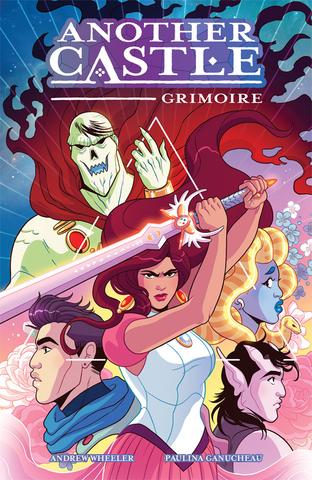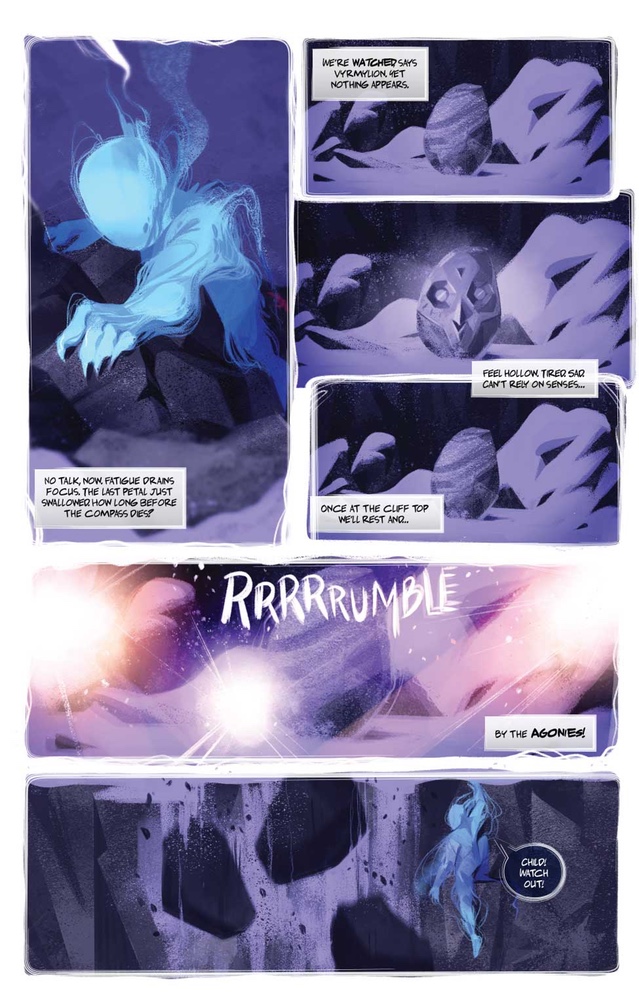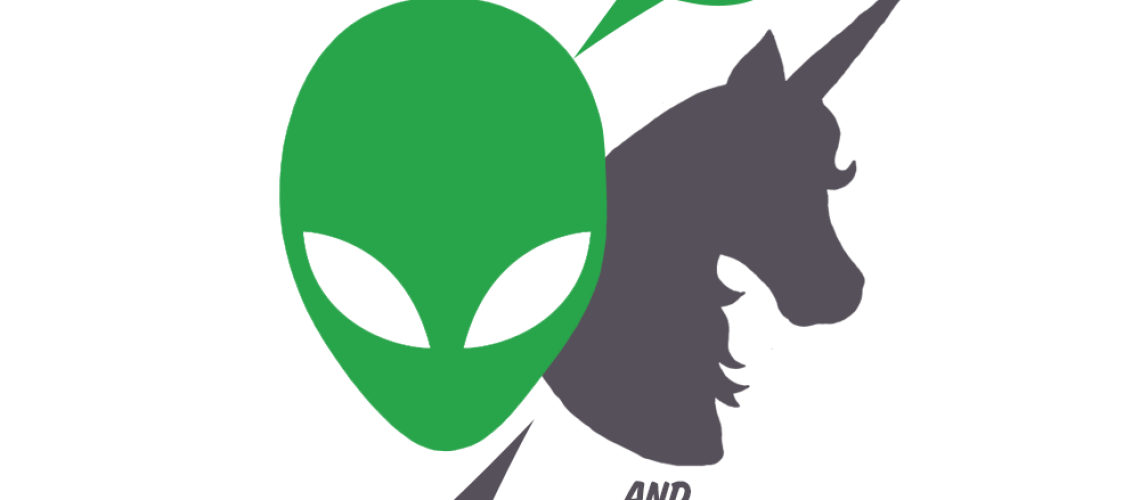Welcome to the latest installment of my comics review column here at Skiffy & Fanty! Every month, I use this space to shine a spotlight on SF&F comics (print comics, graphic novels, and webcomics) that I believe deserve more attention from SF&F readers.
This month, the SF&F awards season is upon us, and I’m going to take the opportunity to reach out to those of you nominating for the Hugo Awards to recommend five works that I believe are deserving of your consideration in the Best Graphic Story category. (These reviews may contain spoilers!)
One of my biggest personal goals with these reviews — I mention this in the introduction to every column, and unpacked it a bit in my Month of Joy post — is to bring more, and different, deserving SFFnal comics, webcomics and graphic novels to the attention of SF&F readers.
That’s especially important when when it gets to be Hugo nomination season; I want to see a diverse, inclusive, smart Best Graphic Story category that reflects the breadth of the material that’s out there, and I want other genre readers to have the chance to find and fall in love with those comics, like I have.
Another Castle: Grimoire

Written by Andrew Wheeler, illustrated and colored by Paulina Ganucheau, lettered by Jenny Vy Tran, designed by Hilary Thompson, edited by Ari Yarwood, published by Oni Press
The subject of my very first review for Skiffy & Fanty is also an excellent candidate for the Best Graphic Story Hugo. Another Castle: Grimoire is smart, fun, accessible, and strongly executed on every front. Maybe most significantly, it’s a work that’s truly in dialogue with the fantasy genre, exploring ideas and challenging assumptions. It’s the absolute definition of the sort of graphic novel that I knew could all too easily fly under the radar of SF&F readers, and that’s very much deserving of wider recognition.
Beanworld Book 4: Hoka Hoka Burb’l Burb’l

Created, written and illustrated by Larry Marder, edited by Philip R. Simon, published by Dark Horse Books
Beanworld, on the other hand, is more of a challenge for new or casual readers, as I noted when I reviewed it in August, 2017. Heck, just from a Kremlinology standpoint, Hugo voters tend to support first volumes for the Best Graphic Story Award more readily than they do later volumes. But sometimes, you just have to go with your heart and support what you love, and I really love Beanworld. This “ecological romance” about a society of thinking beings — the Beans — who live in balance with their world, and how they struggle to incorporate new ideas, new technologies, and changes taking place in the wider universe into that balance — may not fall easily into either fantasy or science fiction, but it’s the definition of excellent speculative fiction.
Oglaf
[Sorry, no preview for this one! All the best excerpts from Oglaf are either NSFW or would spoil a really great gag. You’re just going to have to check it out for yourself, keeping that NSFW warning in mind, of course — Stephen]
Created and written by Doug Bayne and Trudy Cooper, art by Trudy Cooper, published online at Oglaf.com
Yes, there are SFFnal comics that I loved in 2017 and managed to not review, and Oglaf is most of them. It’s wonderful and hilarious and smart and beautiful and effortlessly diverse and takes sharp, critical looks at fantasy tropes. And it’s frequently dirty as anything.
The creators describe Oglaf as an attempt to make pornography that “descended into sex comedy pretty much immediately.” Not every installment deals with sex, or sexual themes, but many do. Most are also stand-alone; while there are recurring characters there isn’t really an over-arching plot anymore (the comic was more serial and ongoing earlier in its run, but that’s fallen away completely). It’s actually possible, using the index, to read only the clean, safe-for-work parts of Oglaf, and while I think you’ll be missing a long of the fun, you’ll still laugh a lot. Like, a lot. A lot a lot.
The comic, in short, is great fantasy, and great fun. Given the requirements of the Best Graphic Story Hugo, it’s challenging to pick only one strip to recommend from 2017, but I’m going to try. Check out ‘Kill The Messenger’ — you’ll get the website’s content warning first, but this particular bit has some slightly raunchy language but no adult content — and see if you don’t see why it merits a Hugo nomination. It’s a two-parter, click ‘Next Page’ to see the rest.
Ragmop

Written and drawn by Rob Walton, published online by Vault Comics
Smart, savvy, wonderfully drawn and also just both fun and funny as heck, Ragmop exemplifies the kind of wild mishmash of gags, references, and kitchen-sink ideas that only comics and comedic SF can really ever manage to pull off. But there’s also a fascinating question posed at the heart of the story that makes it truly, and powerfully, a work of speculative fiction (in between jokes about a giant chicken fighting kaiju) — what if the conspiracy theories were true? All of them? Science fiction at its best is, or can be, fiction that doesn’t just pose its premises, but interrogates them, and Ragmop does exactly that, managing to make hilarious sort-of sense of a world where reptilians from Draco with secret Antarctic saucer bases and a kinky appreciation for fruit are being opposed by Alice Hawkings and her three dinosaur friends. I’ve loved Ragmop for a long time, as my October 2017 review notes, and I was delighted that this new, online incarnation gave me more of it to love.
‘Winter’s Shell’

Written by Sean and Rachel Qinsulak-Tinsley, art by Alexandria Neonakis, from the Moonshot: The Indigenous Comics Collection Volume 2 anthology, edited by Hope Nicholson, published by AH Comics
As my July 2017 review indicates, there’s a surfeit of Hugo-worthy stories in Moonshot Volume 2; while not all the stories fall within the SFFnal genres, many do, and they’re consistently excellent. But this piece, in particular, is both an excellent work of comics, and an excellent work of SF&F. An evocatively-drawn science-fantasy set in a maybe-future, maybe-other Arctic, with rich but not intrusive worldbuilding, that grapples with issues of family love and family conflict, and the embrace of the risk of change versus fear of the future, this comic exemplifies the intersection of comics and genre in a way that truly merits a Best Graphic Story Hugo Award.
And of course, these five works only scratch the surface of Best Graphic Story-worthy SF&F comics published in 2017.
There are other titles that I think are tremendously deserving of future Hugo love, but that perhaps wouldn’t be best served by nomination this year. That’s because of the Hugo requirement for the nomination of discrete works in this category. So, for instance, Moonstruck, which I have gone on record more than once as adoring, has a collected volume of the first five issues coming out in March 2018. It’s more likely to stand out and be recognized if the collection is nominated next year, rather than an individual chapter in the form of a single issue being nominated this year.
The same goes for the brilliant Kaijumax — Season Three came out as single issues over the course of 2017, but the collection is due out later this year. That makes it another great candidate for next year’s Hugos.
Then there are works like My Favorite Thing is Monsters, by Emil Ferris. It’s one of the most acclaimed graphic novels of 2017, and it’s fantastic — but not not quite fantastical (although very suitable for and deserving of its Stoker Award nomination for Superior Achievement in a Graphic Novel).
That doesn’t even begin to touch on the SF&F comics from 2017 that I haven’t read yet — works that wound up on multiple best-of-the-year lists — like Jillian Tamaki’s Boundless (Drawn & Quarterly), Magdalene Visaggio and Eva Cabrera’s Kim & Kim (Image), Faith Erin Hicks’s The Nameless City: The Stone Heart (First Second), Jonathan Hickman and Tomm Coker’s The Black Monday Murders (Image), Brenden Fletcher, Cameron Stewart and Babs Tarr’s Motor Crush (Image), Shade the Changing Girl: Earth Girls Made Easy, by Cecil Castellucci and Marley Zarcone (DC)…
And that’s just what’s on my TBR pile right now.
2017 was a remarkable year for science fiction and fantasy comics, maybe even a banner year (and 2018 is already shaping up to be just as strong). There’s a tremendous opportunity for Hugo voters this year to nominate works that represent the true breadth and depth of what comics can achieve as SF&F. So keep reading, widely and broadly. Keep finding what you love, and keep telling the world, whether that’s by nominating, Tweeting, reviewing, or any other way you choose to share. We’ll all benefit, and we might just end up with the strongest Best Graphic Story Hugo ballot ever.
These thoughts have been submitted for your consideration.
Acknowledgements and Disclosures: I would like to acknowledge that Toronto, and the land it now occupies, where I live and work, has been a site of human activity for 15,000 years. This land is the traditional territory of the Huron-Wendat and Petun First Nations, the Seneca, and most recently, the Mississaugas of the Credit River. The territory was the subject of the Dish with One Spoon Wampum Belt Covenant, an agreement between the Iroquois Confederacy and Confederacy of the Ojibwe and allied nations to peaceably share and care for the resources around the Great Lakes. This territory is also covered by the Upper Canada Treaties. Today, the meeting place of Toronto is still the home to many Indigenous people from across Turtle Island. I am grateful to have the opportunity to live and work in the community of Toronto, on this territory.
Please see my reviews of Another Castle: Grimoire, Beanworld Book 4, Moonshot Volume 2 and Ragmop for my detailed disclosures about those works; in short, I have no relationships with anyone involved that I think unduly biased me, and obtained my own copies of the works, except for Ragmop, which is free online. Similarly, I have no relationships that I’m aware of with the creators of Oglaf, and the comic is online for anyone to read at no cost.








4 Responses
Re: your comments regarding the eligibility of Moonstruck and Kaijumax — Season Three, that they came out as single issues over the course of 2017, but the collections are due later this year. My understanding of the Hugo rules is that eligibility is determined by when the individual issues of a series are published; that collected volumes are considered reprints. This would, it seem, also apply to one of my favorites of the year, Black Hammer, in which issues 7-12 were published in 2017 but the trade didn’t come out until January 2018, making it eligible for this year’s Hugos.
Arno, thank you for your comment. I have to admit that I sometimes find the criteria for the Hugos confusing, so my first thought was that it was entirely possible that I was wrong, or that my information was outdated.
And further reading confirmed that I was indeed at least partly wrong! But the way I was wrong happily doesn’t reflect the eligibility of Moonstruck or Kaijumax in the end!
Here’s an overview of the official rules of the Hugo Award: http://www.thehugoawards.org/hugo-categories/
The key issue for collected works like graphic novels that compile runs of comic books, or instalments of a webcomic in the Best Graphic Story category is that they’re serialized works. Per the Hugos website:
“Works such as TV series, comics and sometimes even whole novels are sometimes published in multiple parts making up a complete story arc. The individual elements of such a story arc are always eligible for their year of publication. However, voters may want to nominate a complete story arc. In such cases it is the publication date of the final installment of the series that counts for eligibility purposes.
If an individual installment of a story arc achieves a nomination on its own then the complete story arc will probably be ruled ineligible if nominated. This is because the voters have clearly indicated that the installment stands on its own as a complete work and is not part of a longer work. (The same would apply if, for example, book 1 of a trilogy were to be nominated on its own.) ”
So, I misunderstood some of the rules, but it still works out for both Moonstruck and Kaijumax. Moonstruck #5 and Kaijumax #6, which conclude their respective story arcs, were published in January 2018, with the collections to follow this year.
In both cases, I think my point that the works are likely to stand out if the entire story arc is nominated next year, rather than individual issues, is correct, even though some of my background information that led to that conclusion was off!
But it’s not entirely clear to me how that would play out for a work like Black Hammer (which I haven’t read yet, but is on my TBR pile!), where the serialized run of individual issues #7 to 12 concluded in 2017, and I believe the collection came out in 2018. It might come down to a judgement call by the Hugo administrators, and on factors like whether the collected volume had any new or supplemental material.
The same, sadly, might be true of Another Castle: Grimoire, which was published in early 2017 as a collection of individual comics issues, all published in 2016. It would be unfortunate to have missed the window of eligibility for this excellent graphic novel, but I think it’s worth trying. The Hugo admins have noted in the past that when there isn’t absolute clarity, it’s generally best to err on the side of nominating.
Similarly, there’s certainly nothing from stopping you from nominating Black Hammer #7 to 12 as a discrete story arc for THIS year’s Hugos; it looks to fall safely within the eligibility criteria, so that might be the safest and best option. The question is whether the collection would also qualify for NEXT year’s Hugos. Certainly not if it gets on the ballot this year, but if not and you and others try again? My layperson’s interpretation of the rules as I now understand them is… I think maybe not?
But given my obvious confusion above, I’m hardly an expert! We’d really need to consult someone more deeply immersed in Hugo Lore than me.
Thank you for raising this issue. It led to me getting more and needed clarity around the Hugo rules.
I think you have summed up the rules nicely. I was indeed planning to nominate Black Hammer 7-12 just to be clear that it is the original story arc and not the trade collection. Sometimes the Hugo rules can be quite arcane, and are certainly misinterpreted occasionally.